
The medical device industry is highly regulated to ensure product safety, effectiveness, and compliance with international standards. Medical Device Certification is essential for manufacturers and distributors aiming to enter global markets. Various regulatory bodies such as the US FDA, EU MDR, ISO 13485, and CDSCO in India mandate compliance requirements for different types of medical devices.
In this guide, we provide an in-depth understanding of Medical Device Certification, its importance, and the step-by-step process for obtaining approvals worldwide.
What is Medical Device Certification?
Medical Device Certification is the process of obtaining regulatory approval from national and international authorities to ensure that medical devices meet safety, quality, and performance standards. Different certifications apply to various markets:
- FDA (Food and Drug Administration, USA) – For medical devices sold in the US.
- CE Marking (European Union Medical Device Regulation – MDR) – Required for the European market.
- ISO 13485 – A global quality management system standard for medical device manufacturing.
- CDSCO (Central Drugs Standard Control Organization, India) – Required for medical device approval in India.
- TGA (Therapeutic Goods Administration, Australia) – Certification for the Australian market.
Why is Medical Device Certification Important?
- Market Access – Enables manufacturers to sell products in domestic and international markets.
- Legal Compliance – Ensures adherence to national and international regulations.
- Product Safety & Quality Assurance – Guarantees that medical devices meet safety and performance standards.
- Competitive Advantage – Enhances brand credibility and trust among consumers and healthcare professionals.
- Avoiding Legal and Financial Penalties – Non-compliance can lead to product recalls, penalties, and bans.
Key Medical Device Regulatory Certifications
1. US FDA Approval (United States)
- Class I, II, III Classification – Devices are categorized based on risk level.
- 510(k) Premarket Notification – Required for most Class II devices.
- PMA (Pre-Market Approval) – Needed for high-risk Class III devices.
- QSR (Quality System Regulation) – Ensures compliance with good manufacturing practices.
2. CE Marking (European Union)
- Compliance with MDR (Medical Device Regulation 2017/745).
- Conducting Clinical Evaluations and Performance Testing.
- Engaging a Notified Body for Certification Approval.
3. ISO 13485 Certification
- International quality management system (QMS) standard for medical device manufacturing.
- Ensures consistency in design, production, and post-market surveillance.
4. CDSCO Certification (India)
- Import & Manufacturing License for medical devices under India’s Medical Device Rules (MDR), 2017.
- Requires registration with the CDSCO and approval from the Drug Controller General of India (DCGI).
Medical Device Certification Process
Step 1: Determine the Classification of the Medical Device
- Regulatory authorities classify medical devices based on risk (Class I, II, III).
- Higher-risk devices require more stringent testing and approvals.
Step 2: Conduct Preclinical & Clinical Testing
- Performance and safety evaluations, including biocompatibility, electrical safety, and sterility testing.
- Clinical trials may be required for high-risk devices.
Step 3: Prepare Technical Documentation
- Includes device specifications, risk management reports, manufacturing processes, and labeling requirements.
- Must align with ISO 13485 and other regulatory standards.
Step 4: Submit Application to Regulatory Authorities
- Submit required documents to the FDA, EU Notified Bodies, CDSCO, or other regulatory agencies.
- Pay applicable fees and respond to regulatory queries.
Step 5: Obtain Certification & Market Approval
- After successful review and audits, regulatory bodies issue certification for market entry.
- Compliance with post-market surveillance requirements is mandatory.
Common Challenges in Medical Device Certification & How to Overcome Them
- Regulatory Complexity – Regulations differ across countries; expert guidance is essential.
- Clinical Trial Requirements – Higher-risk devices require extensive clinical testing.
- Changing Compliance Standards – Manufacturers must stay updated with regulatory changes.
- Delays in Approval – Working with regulatory consultants speeds up the certification process.
How Certify Genesis Can Help with Medical Device Certification
At Certify Genesis, we assist medical device manufacturers in obtaining FDA, CE, ISO 13485, and CDSCO certifications. Our services include:
- Regulatory consultation and compliance strategy.
- Technical documentation preparation.
- Clinical trial support and testing coordination.
- Filing applications and post-market compliance assistance.
Conclusion
Obtaining Medical Device Certification is crucial for ensuring compliance, market entry, and consumer trust. Understanding different regulatory requirements and following the correct approval process is essential for success in the global medical device industry.
For expert assistance in Medical Device Certification, contact Certify Genesis today!
FAQs
Q1: How long does it take to obtain Medical Device Certification?
A: The timeline varies based on the certification type, device risk classification, and regulatory body, typically ranging from 3 months to 1 year.
Q2: Is ISO 13485 certification mandatory for all medical device manufacturers?
A: While not always mandatory, it is highly recommended for global market access and regulatory compliance.
Q3: What is the difference between FDA approval and CE marking?
A: FDA approval is required for medical devices in the US, whereas CE marking is for the European market under MDR regulations.
Q4: Can a foreign manufacturer apply for CDSCO certification in India?
A: Yes, but they must appoint an Authorized Indian Representative (AIR) for regulatory submissions.
For expert guidance and seamless certification, Certify Genesis is here to help!
